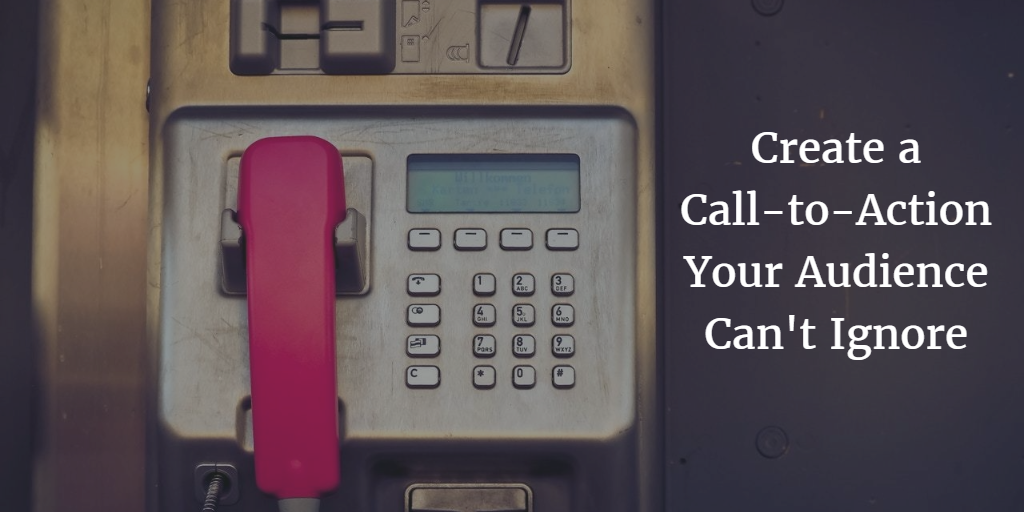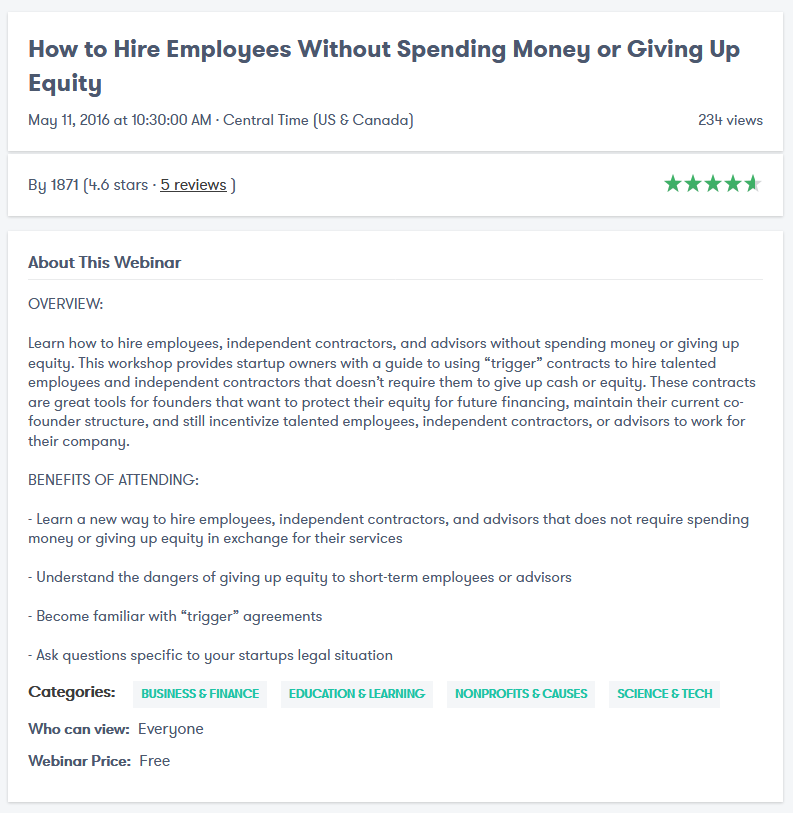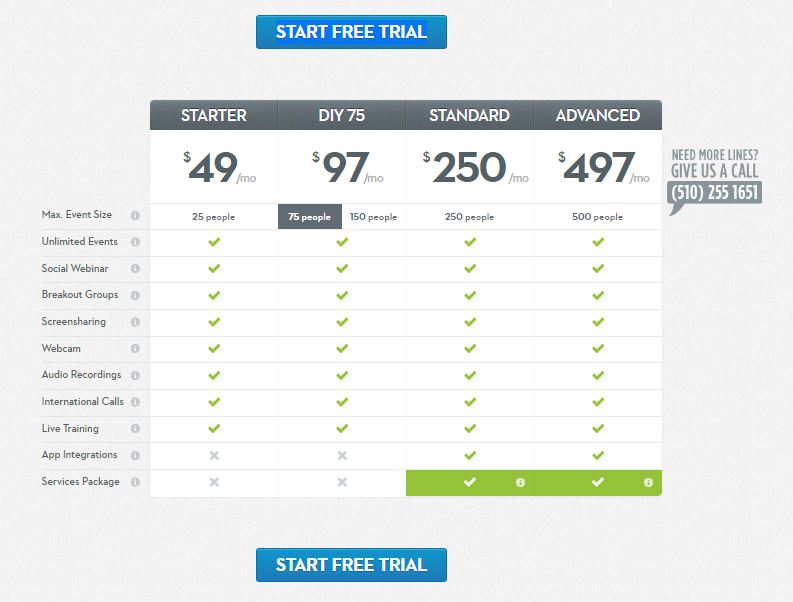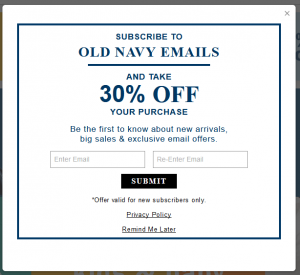4 Tips for Creating an Irresistible Call-to-Action for Your Webinar
How would you describe your ideal webinar call-to-action (CTA)?
Take a moment to think about it. After all, your call-to-action is critical for traffic conversions and improving your sales funnel. It is THE action you want to call upon your webinar audience to perform.
Your description may be something along the lines of, ‘my ideal webinar CTA should’:
- Be compelling!
- Convert a large number prospects into attendees.
- Keep conversion rates high at a low cost.
These are all good descriptions, and yet they highlight the fact that getting visitors to sign up for your webinar can be difficult. Visitors will abandon the landing page before entering their email address, they’ll ignore your newsletters, they’ll scroll pass your videos.
Considering all this, it is important to realize that your call-to-action plays a central role in the sales process and must be crafted carefully. If you can create irresistible and effective CTAs, you’ll increase conversion rates, reduce ad spend and improve ROI.
Here’s one line that encompasses all you should desire in your call-to-action.
Your call-to-action should be crafted such that your visitors can’t help but do it, whatever “it” is. Your CTA should be irresistible.
Here are some tips for creating a powerful, effective, irresistible call-to-action:
Tip #1: Focus On The Value and Qualify Your Call-to-Action
If I had to choose the first and foremost rule of online marketing, it would be providing value. If you are providing value with your products and services, then why would you slack off on providing value with your outreach?
What really is VALUE?
Answering this question begins with thinking about your customers. What issues do they face? What are their pain points? What keeps them up at night?
All that thinking about your customer leads to questions such as, how can I solve their problems? How can I ease their pain? How can I create something they will consider worthwhile? If you can answer all these questions, then you understand how to provide real value for your customers.
Ideally, you should always aim to provide more value to your customers than you receive from them in return.
The art of creating added value starts with the ability to see your business through the eyes of your customers.
It’s about helping as opposed to just selling.
Why is this important to this discussion about CTA?
Explaining value is as important as providing value. In other words, selling value is as important as selling products and services. After all, that’s how you get to your call-to-action in the first place. You build up to it by explaining the value of your offer. The call-to-action itself is not even the icing on the cake but it’s the cherry on top. There’s a lot of work that needs to be done before presenting the call-to-action. This is how you build trust with your audience.
It’s about emphasizing the value of your offer. What will the user get out of completing the call-to-action?
When considering value, answer the following questions from the perspective of a potential customer:
- What’s the immediate benefit?
- What’s the benefit in the long run?
- Why should I choose this product/service as opposed to another?
- Why should I take action now as opposed to another time?
Infomercials do great with conveying value. Typically, before the offer is made, the problem is identified and the effect of the problem is explored. Then, they present a product or service to solve the problem. That’s how infomercials have been structured for years. For a simple reason – it works! Follow a similar strategy –qualify your call-to-action before presenting it.
Tip #2: Reassure Your Ideal Customer
So you have successfully built up your call-to-action and the customer is just about ready to take that action but a sense of doubt lingers. When you expect customers to take action you should work hard to reassure them that the action they’re about to take is worth taking in the end (again with that value from Tip #1).
Picture yourself as the customer. You’re thinking for a few seconds before making a substantial purchase. It could be that expensive smartphone that was just released or even booking a weekend at an expensive resort. And yet, just a few short days before, you were completely sure you wanted to purchase the phone, completely sure you wanted to go to that resort. However, at the appointed time of purchase, the commitment is in front of you. The commitment is real and present and it conjures up doubts. This is when the worrisome questions kick in. Questions such as “Is this a right choice?”, “Do I really need this?” or “Should I look for some options?” and on and on.
So how do you stop this fear and create a sense of security?
Start from a place of honesty and a real desire to help. That means your statements of reassurance should not be empty marketing ploys. It means that in as much as they help your right customer to sign up for your webinar, they should turn away undesirable customers.
Here’s an example:
Jane arrives on your webinar landing page looking for an event to learn about “How to create an agency specializing in offline marketing.” If your webinar is about creating agencies specializing in digital marketing, then Jane is clearly not your ideal customer. Part of your assurance should clearly state that this offer is for people looking to create ‘digital agencies.’ This will help to assure your ideal customer and filter out those who don’t really need to join.
Let’s see how you could go about this. First, compile a list of the most worrisome issues that might pop up in the minds of your ideal customers. Craft your best and honest responses to put their minds at ease. Present these just before the call-to-action.
Once you have successfully qualified the CTA, the call-to-action itself should finally reiterate/emphasize/reassure why your target audience should complete your offer. For instance, if the call-to-action is on a button, it should spell out (literally) what will happen when the button is clicked, and not just show a vague offer to click the button. For example, your call-to-action for a graphic design freelancing webinar could say ‘Become a Graphic Design Freelancer’ as opposed to simply ‘Join Here.’ The former is crystal clear, I am reassured that clicking on the button is the next step I want to take; for some people, the latter can be terrifying – join what, a cult?! What am I getting myself into?!
Tip #3: Limit Choices. Less is More When it Comes to Choices
We all suffer from a paradox of choice. We will find it quite easy to choose between peanuts and almonds; however, presenting someone with peanuts, almonds, pistachios, cashews and Brazil nuts is a recipe for indecision.
In the preface of his book exploring consumer choice patterns, ‘The Paradox of Choice’, psychologist Barry Schwartz described how he once went out to buy a pair of jeans. Schwartz entered the store fully prepared to buy a 28-32 size pants. Pretty simple right? Well, the salesperson presented him with several fit types including slim fit, baggy fit, regular fit, easy fit, etc., all in size 28-32. The decision became far more difficult than he had expected.
It is important that your sales funnel is very specific and straightforward. Offer your prospects clear choice, otherwise, they will end up confused. Consumers just want to be guided by an expert (you). Offering them a clear choice demonstrates that you are knowledgeable and know what’s best for them. Offering one (or maximum three) clear choice(s) demonstrates the importance of said choice and removes any doubt or room for indecision. This is critically important for online marketing wherein choices are plenty and people are suspicious. You need your prospects to take action quickly and the clear choice aids in that.
Think about it this way, the more choices you present (beyond those that are essential), the fewer people will participate.
Disadvantages of Offering Several Choices
- No guidance: Lack of guidance reduces trust and decreases your stance as an authority. Confidence creates trust and lack of guidance impedes conversions.
- No clear path: Not offering a clear path within your sales funnel will result in your prospects ending up where you don’t want them to (in most cases, out of the funnel).
- People buy less: A study done at Columbia University stands as a classic example that illustrates the fact that consumers purchase less when presented with many choices. The study found that people buy more jam when presented with six options rather than 24 options.
How to Limit Multiple Choices
- Single Effective Call-To-Action. Have one effective call-to-action for each stage of the sales funnel. This doesn’t mean you should have a single instance of the CTA. It just means wherever the call-to-action is mentioned, it should say the same thing (or very similar). It should lead all prospects to the same place in the next stage of the funnel.
- Weighting: If you must offer multiple choices, give added weight to one choice over the others. This will help your prospects choose a more specific path. Choose the path you prefer everyone to take and give more weighting to that. This weighting could be a highlight or a recommendation. Many companies do this with pricing plans.
Tip #4: Don’t Misalign Your Call-to-Action with the Visitor’s Stage in the Sales Cycle
The simplest of funnels follow the following stages:
- Awareness-Interest: This stage provides information and creates interest. It includes ads, blog posts, whitepapers, eBooks, webinar promos, videos, etc.
- Evaluation-Desire: This stage presents the offer in a more concrete way and tries to bring the prospects to make a decision and become a customer. This stage includes product webinars, demo videos, etc.
- Purchase: This is the action stage. It includes free trials, coupons and everything else related to the final purchase.
The linkages to each stage should be effective calls to action. However, due to the differences between each stage, your CTA should have different objectives:
- From Awareness to Evaluation: The purpose of your call-to-action at this stage is to build interest, to entice the customer to get more information.
- Evaluation Stage to the Purchase Stage: At this stage, your call-to-action should be actionable and prompt the prospect to take real action after sufficiently emphasizing the value of the product/service.
It’s important that your call-to-action align with the different stages of the sales funnel. For example, if someone is signing up for a webinar on ‘How To Use The Power Editor To Maximize Facebook Ads,’ they are obviously further along the sales process than if they are just signing up for a webinar on ‘How To Create Facebook Ads.’ As such, it doesn’t make much sense to offer a general eBook on Facebook ads as an incentive to sign up for the webinar related to the power editor. Once you have the right offers at each stage of the funnel, then aligning your call-to-action towers those.
What happens when your call-to-action isn’t at the correct place in the funnel?
Your prospect won’t take action, it’s as simple as that.
Here’s an example:
The other day, I went over to OldNavy.com to check out their new arrivals. I was immediately presented with a popup that promised a discount in return for my email address. The issue is, I had not seen any products as yet.
While I would generally appreciate the discount, at that point in time (when I arrived at the site), I had no interest in it because I was not sure whether I was going to make a purchase. The appropriate place for this CTA is on the purchase page. At that point in the funnel, I’ve almost made a commitment to purchase, so offering a discount then provides additional incentive to press that ‘purchase’ button.
It’s important that you understand where your prospects fall in your sales pipeline and what the next logical step is. This way, you will craft your call-to-action appropriately and see greater conversions.
Over To You
If your call-to-action is poor, you’ll have better luck herding cats than getting people to take action. After spending hours creating content and marketing resources, don’t cheat yourself with a subpar CTA. Remember, you haven’t converted a customer until he/she has completed the final action.
Now it’s time for OUR CTA–>Please click here to share this post on social media!







